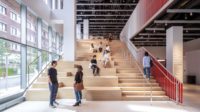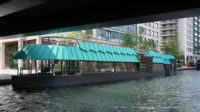A Czech Monastery's Multi-Use Public Pavilion Pays Homage to the Architect of Modern Genetics
.jpg?t=1687274434&width=1080)
.webp?t=1687128440&width=1080)
Photo © Laurian Ghinitoiu
.webp?t=1687128453&width=1080)
Photo © Laurian Ghinitoiu
.webp?t=1687128463&width=1080)
Photo © Laurian Ghinitoiu
.jpg?t=1687274434&width=150)
.webp?t=1687128440&width=150)
.webp?t=1687128453&width=150)
.webp?t=1687128463&width=150)
Architects & Firms
Abbot Gregor Mendel established the groundwork for modern genetics in the mid-19th century, pioneering the concept of dominant and recessive traits passed from one generation to another. The greenhouse he used to conduct his experiments in cross-breeding varieties of peas was destroyed by a storm in the 1870s, but the 14th-century Augustinian monastery in Brno, Czech Republic, where he lived and worked remains active today. To honor his legacy and invite the public to explore its grounds, the monastery commissioned Czech architecture and urban design studio Chybík + Krištof (a 2019 Design Vanguard firm) to design a pavilion on the site of the greenhouse.
Photographs of the original greenhouse and remnants of its foundations informed Chybík + Krištof’s approach to the project. Leaving those foundations intact below ground, the architects poured new ones for their building but followed the footprint of the old structure. They also alluded to the old roof in the angle of theirs, while changing the shape from a gable to a single slope. The simple form of the new, one-story building defers to its larger neighbors, while its glass-and-steel material palette sets it apart from the historic fabric of the monastery all around it. “Context is key to all our work,” says Ondřej Chybík, explaining his firm’s respect for the site and what had been there.
.webp)
Photo © Laurian Ghinitoiu
.webp)
Photo © Laurian Ghinitoiu
.webp)
Aerial view of St. Augustin Abbey in the historic heart of Brno, Czech Republic. Photo © Laurian Ghinitoiu
.webp)
Photo © Laurian Ghinitoiu
.webp)
Photo © Laurian Ghinitoiu
To reduce the impact of the sun, the roof is shaded by hybrid-textile blinds that roll out when needed. A 9.8-inch gap between the blinds and the roof allows air to circulate and cuts the need for conditioned air inside. In addition, clerestory windows near the top of the tall north facade encourage natural ventilation. Minimizing the height of the south side also reduces exposure to the most direct sunlight, while generous eaves around all facades provide protection as well. To prevent birds from colliding into the building, the architects considered applying ceramic dots to the glass. But because the pavilion is surrounded by trees and taller buildings, they determined that such a measure wasn’t needed. According to Chybík, that has proved to be correct.
To develop the pavilion’s structural system, Chybík and Krištof interpreted Mendel’s diagrams of the way genetic traits are passed from one generation to another. Imagining the main steel columns as the building’s parental generation, the architects designed slender steel cables crisscrossing the interior volume as if they were second and third generations exhibiting dominant and recessive traits. “We aimed to translate Mendel’s laws into architecture,” says Chybík. Just as peas and people evolve over time, this elegant pavilion shows how even an institution like a 600-year-old monastery can change and embrace new technologies without losing its identity.


Drawings of Mendel's Greenhouse at St. Augustin Abbey, Brno. Images courtesy Chybík + Krištof





.jpg)
.webp)
.webp)
.webp)